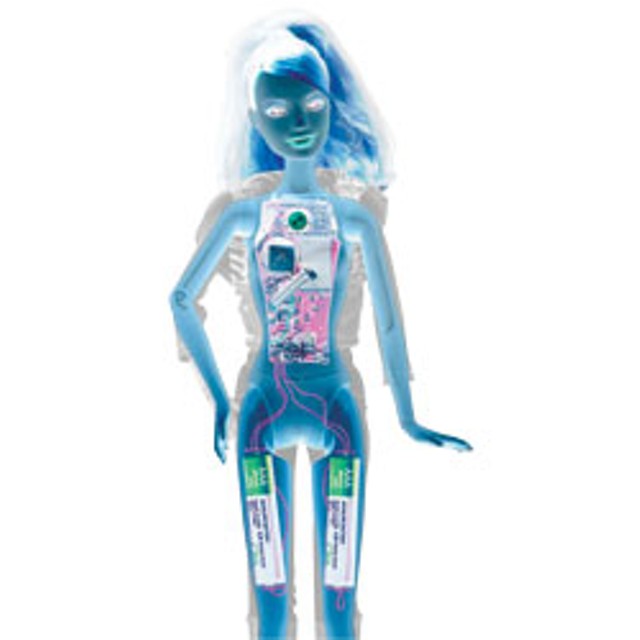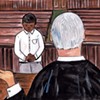Published December 8, 2010 at 7:45 a.m.
“The FBI focuses on threats that challenge the foundations of American society or involve dangers too large or complex for any local or state authority to handle alone,” says the bureau’s official website. Its targets? Terrorists, spies, cybercriminals, organized crime, corrupt public officials…
And Barbie.
Only a few weeks ago, Barbie Video Girl, whose built-in camera can record for a half hour, was at the top of the hottest-toys lists.
Then last week, photographers were catching her in a perp walk. A leaked FBI memo warned that Barbie Video Girl is a “possible child pornography production method.”
The memo made no mention of the equally suspicious fact that Video Girl is a cyborg.
Poor Barbie. The ever-youthful, 11.5-inch-tall 51-year-old — who asks nothing from life beyond a few new outfits — had been indicted, again, for the corruption of minors.
Right out of the box, in 1959, there was the problem of her breasts — that she had them. Then came her exclusive whiteness, not appreciated by the civil-rights organizations. In 1992, the American Association of University Women was up in arms about her math anxiety. (Mattel quickly eliminated “Math is so hard!” from Teen Talk Barbie’s 270-phrase vocabulary.)
In 2009, Barbie got a tramp stamp reading “Ken” — no doubt without Mom’s permission. The same year, after multiple failures to produce a credible doll of color, Mattel introduced the marginally more authentic So In Style line. But why does So In Style Grace come with a child, Courtney? Is she a single mother?
Through it all, the perennial cry against Barbie has been against her freakish proportions, which, critics say, make girls hate their own bodies.
And now Barbie is an accessory to the crime of child pornography. She could right now be grooming little Courtney for sexual abuse.
We should have seen this coming. Because Barbie has entered the crosshairs of a new protest movement: SPARK — Sexualization Protest: Action, Resistance, Knowledge. Launched this fall at a “summit” in New York, SPARK aims to combat what its members see as an unprecedented proliferation of sexed-up, dumbed-down representations of girls and women in media, fashion and toys. “Sexualization” is the purported harm attached to these images.
“Sexualization” first gained wide attention in 2007, with a report from a task force of the American Psychological Association (APA). The report defined sexualization as occurring when a person feels her value comes only from her sexual appeal; when she believes she’s sexy only if she fits a narrow (white, thin, young) standard of beauty; when she is “objectified — that is, made into a thing for others’ sexual use,” rather than viewed as an autonomous person; and/or when “sexuality is inappropriately imposed upon [her].”
The report cited voluminous evidence of the harms sexualization inflicts on prepubescent and teenage girls, from anorexia to straitened career aspirations to a failure to develop “healthy sexuality.” It placed sexualization on a “continuum” with sexual abuse and child prostitution and pornography.
Since 2007, scores of books, blogs, committees and even a congressional bill targeting sexualization have appeared. Feminist allies climbed aboard.
Yet some of the greatest enthusiasm for the cause hails from the Right. After all, for decades Focus on the Family, Concerned Women for America and the Parents Television Council have been protesting the vulgar media’s corruption of children. Had the APA called its enemy “sexism” or “feminization” — that unbearable pinkness of being female — conservatives would have stayed a mile away. But America’s moral guardians could get behind the idea of “sexualization,” which implies that children are not sexual until someone tells them to be.
In fact, they blame feminism for the problem. As conservative writer Joseph D’Agostino told the National Catholic Register: “Back in the bad ol’ prefeminist days, when women were so oppressed, teen girls were concerned with getting better grades and improving their social graces. Now they want to look hot. Write Gloria Steinem today and thank her for what she’s done for America’s girls.”
If you were around in the 1980s, all this may sound familiar. Back then, feminists fed up with sexism took aim at images, too: pornography. At first, they said that pornography only instructed men in violence against women. Soon, they called pornography itself violence; they tried — unsuccessfully, thanks to opposition from other feminists — to outlaw it.
The Right loved the antiporn movement. In 1986, Reagan’s Attorney General Edwin Meese convened a commission on pornography and invited antiporn leaders to testify. Although every “harm” described by witnesses was moral — and unproven — in the end, the commission put in place what would become a massive machine of surveillance of sexual imagery, especially pictures of naked children, including cartoons. A couple I know was charged with possession of child pornography: three pictures of a naked Ken doll taken by their 6-year-old son.
And now the FBI is after Barbie, a too-willing tool for pedophiles and teen sexters.
SPARK’s leaders oppose censorship; they just want more “positive” images. What disturbs them, they say, is how sexualization robs girls of the chance to develop “healthy sexuality” — how it renders girls “sexy but not sexual.” SPARK’s rallying cry: “Take sexy back!”
Perhaps the academics who started SPARK should have been warned that the fine distinction between “sexy” and “sexual” would wash away in the maelstrom of mainstream discourse — and attract folks who don’t want girls (or unmarried women) to be sexy or sexual.
But fine distinctions are hardly the problem with this movement or the social science on which its claims of harm are based. Which are the sexy-making media — the “inappropriate,” “objectifying” and “pornified” representations? Which is the “positive” sexual stuff? They don’t say. In the end, it may come down to taste: As Ellen Willis wryly summarized antiporn rhetoric: “If it turns you on, it’s pornography. If it turns me on, it’s erotica.”
SPARKers feel no affection for the moral Right. In fact, some of their leaders — psychology professors Deborah Tolman, of Hunter College, and Sharon Lamb, of Vermont’s St. Michael’s — are among the few scholars who have studied, and affirmed, girls’ sexual desires.
Yet the roots of SPARK’s ideals grow closer to those of Joseph D’Agostino’s ideals — and indeed, of many Americans’ — than its activists might think.
One example: “healthy sexuality.” Everybody’s for it, but what is it? The APA says it fosters “intimacy” and “bonding” — common code for committed monogamy. It “involves mutual respect,” perhaps an allusion to what it is not: casual or commercial sex, lust for a body as a body — the dread “objectification.” “Healthy,” in our medicalized era, means “normal”; it means moral.
The sexuality that girls would develop were they not brainwashed by Bratz dolls and Miley Cyrus videos is more than a moral ideal, though; it may also be the latest version of an old illusion. For, if the 18th century invented a child innocent of all adult knowledge, and the 19th figured that innocence as sexual, in the 21st century, no one but the Pope denies the reality of childhood sexuality. Still, we long to protect innocence. Healthy child sexuality, unsullied by commerce, kink or even gender — by culture — is 21st-century innocence.
Since the 19th century, the wish for innocence has expressed itself in successive adult hysterias over youth-corrupting media — penny novels, comic books, rock ’n’ roll, video games ... and now the various vehicles of sexualization.
Yet what is sexualization but the leakage of history into desire?
Kids live in history. Why wouldn’t their predominant sexual style be exhibitionism, given their 24-hour on-screen lives? Why wouldn’t they seek quick hookups, when communication is a tweet or a text? Why wouldn’t kids “grow up fast” sexually — as fast as they did in, say, the 17th century — when they know and do everything else adults do: fight wars, trade stocks, survive earthquakes and exile?
Barbie is the least of it.
Thankfully, history has also given us feminism, whose fruits include not only a fictional world of female surgeons and superheroes, but also tough, talented, sexy real women like tennis’ Amazonian Williams sisters and the polymorphically perverse Lady Gaga. Were these women sexualized? What does it mean when the proto-feminist hip-hopper Nicki Minaj calls herself a Barbie? The messages — and, surely, girls’ interpretations of them — are nothing if not ambiguous.
Needless to say, Barbie took her hits at the SPARK Summit. A professor reported on a study in which one group of girls played with Barbies for 10 minutes, and the other didn’t. Asked afterward what they wanted to be when they grew up, the players said it would be nice to be a nurse or a mommy. The nonplayers were aspiring astrophysicists and bank presidents.
I looked around at the audience — confident, professional women and accomplished teenagers, feminists all. I wondered, How many of us did not play with Barbies? In fact, the talk brought me back to a voluptuous childhood fantasy: that I’d awake one morning to find the complete Barbiana — gowns and swimsuits, tippy-toe shoes and roadster — arrayed on my bedroom floor.
Media images of beauty and sexiness are as limited as America’s erotic imagination. Instead of laboring to make our children’s desires more correct, let’s concentrate on nurturing their creativity in pleasure.
Poli Psy
“Poli Psy” is a bimonthly column by Judith Levine. Got a comment on this story? Contact [email protected].
More By This Author
Speaking of Politics
-

Bernie Sanders Sits Down With 'Seven Days' to Talk About Aging Vermont
Apr 3, 2024 -

Al Franken Blends Satire and Political Commentary at Flynn Show
Sep 19, 2022 -

Candidates for Governor Display Stark Differences at Tunbridge Fair Debate
Sep 16, 2022 -

Weinberger Removes Racial Equity Director From Oversight of Policing Study
Mar 16, 2021 -

Sirotkin Criticizes Grant Program — to a Larger Audience Than He Intended
Feb 24, 2021 - More »
Comments
Comments are closed.
From 2014-2020, Seven Days allowed readers to comment on all stories posted on our website. While we've appreciated the suggestions and insights, right now Seven Days is prioritizing our core mission — producing high-quality, responsible local journalism — over moderating online debates between readers.
To criticize, correct or praise our reporting, please send us a letter to the editor or send us a tip. We’ll check it out and report the results.
Online comments may return when we have better tech tools for managing them. Thanks for reading.














































